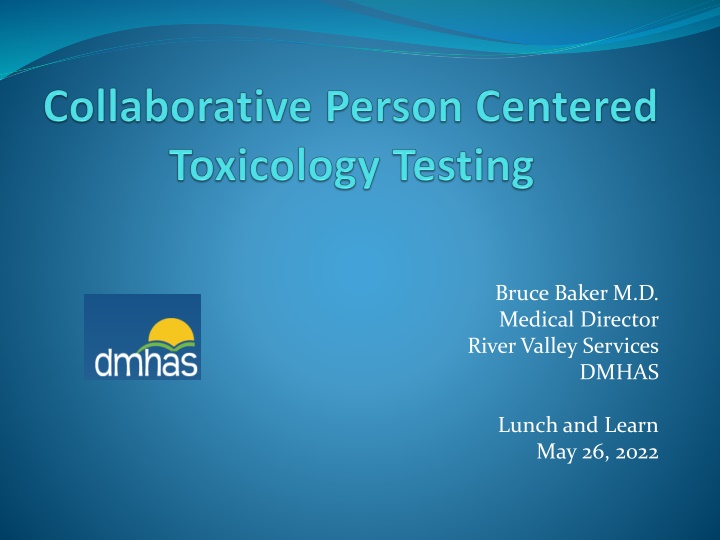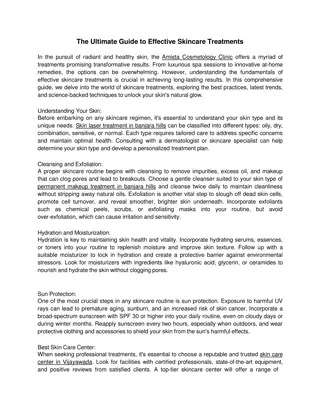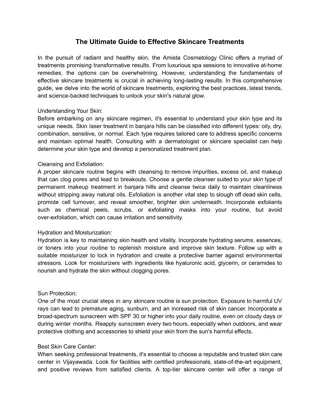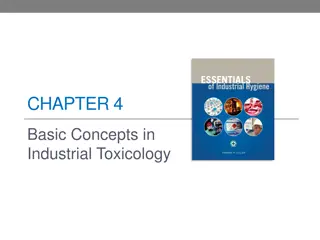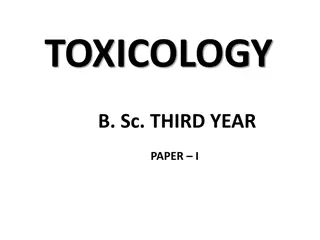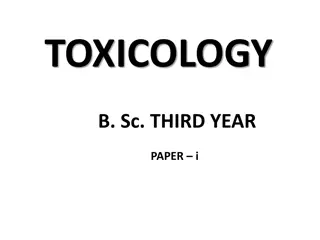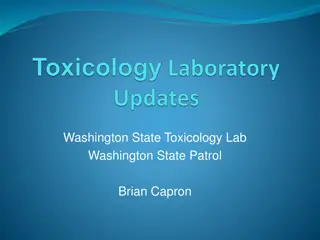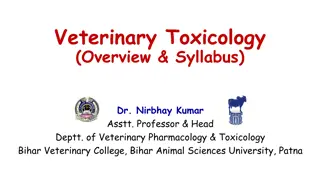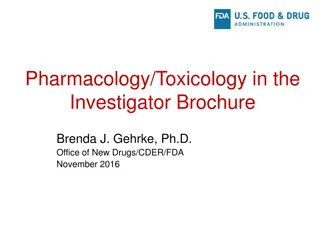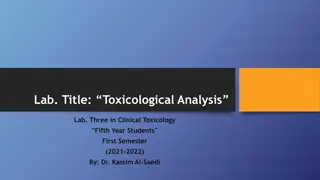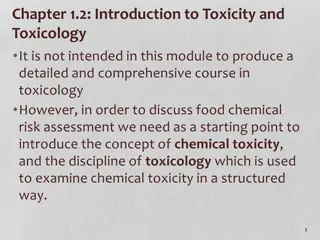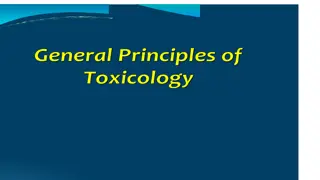Collaborative Toxicology Testing for Integrated Treatments
Toxicology testing is a vital tool in addiction treatment programs, offering assessment, monitoring, and support. It helps in safe prescribing and protects clients from harmful substances. By utilizing drug testing collaboratively and person-centered, providers can improve treatment outcomes and promote patient engagement without punitive measures.
Download Presentation

Please find below an Image/Link to download the presentation.
The content on the website is provided AS IS for your information and personal use only. It may not be sold, licensed, or shared on other websites without obtaining consent from the author.If you encounter any issues during the download, it is possible that the publisher has removed the file from their server.
You are allowed to download the files provided on this website for personal or commercial use, subject to the condition that they are used lawfully. All files are the property of their respective owners.
The content on the website is provided AS IS for your information and personal use only. It may not be sold, licensed, or shared on other websites without obtaining consent from the author.
E N D
Presentation Transcript
Bruce Baker M.D. Medical Director River Valley Services DMHAS Logo DMHAS Lunch and Learn May 26, 2022
OBJECTIVES Understand how toxicology testing functions as a core, person centered support for clients Understand how toxicology testing fits in well integrated COD/SUD treatments and a whole team approach to COD/SUD treatments Understand program design implications of methods of screening; screening vs. lab testing; reading vs. interpreting tests; program elements needed to set up testing DMHAS Logo
NEGATIVE ASSOCIATIONS Toxicology Testing Gotcha Legal consequences Based on distrust of client Shame Adversarial
COLLABORATIVE PERSON CENTERED TESTING
SO WHY TEST? Therapeutic Tool Assessment Monitoring Support Safe Prescribing Help Protect Client from Unknown Substances
SO WHY TEST? -- Therapeutic Tool Drug testing is recommended as a therapeutic tool as part of evidence-based addiction treatment. Providers should utilize drug testing to explore denial, motivation, and actual substance use behaviors with patients. If drug-testing results contradict self-reports of use, therapeutic discussions should take place. The Appropriate Use of Drug Testing in Clinical Addiction Medicine Consensus Statement (ASAM) pg. 5
SO WHY TEST? -- Therapeutic Tool Providers should present drug testing to patients as a way of providing motivation and reinforcement for abstinence. Providers should educate patients as to the therapeutic purpose of drug testing. To the extent possible, persuade patients that drug testing is therapeutic rather than punitive to avoid an us versus them mentality. If a patient refuses a drug test, the refusal itself should be an area of focus in the patient s treatment plan. The Appropriate Use of Drug Testing in Clinical Addiction Medicine Consensus Statement (ASAM) pg. 6
SO WHY TEST? -- Assessment Treatment providers should include drug testing at intake to assist in a patient s initial assessment and treatment planning. Results of a medical and psychosocial assessment should guide the process of choosing the type of drug test and matrix to use for assessment purposes. Drug test results should not be used as the sole determinant in assessment for SUD. They should always be combined with patient history, psychosocial assessment, etc. The Appropriate Use of Drug Testing in Clinical Addiction Medicine Consensus Statement (ASAM) pg. 7
SO WHY TEST? -- Assessment Drug testing may be used to help determine optimal placement in a level of care. Drug testing can serve as an objective means of verifying a patient s substance use history. Drug testing can demonstrate a discrepancy between a patient s self-report of substance use and the substances detected in testing. The Appropriate Use of Drug Testing in Clinical Addiction Medicine Consensus Statement (ASAM) pg. 7
SO WHY TEST? -- Monitoring Drug testing should be used to monitor recent substance use in all addiction treatment settings. Drug testing should be only one of several methods of detecting substance use or monitoring treatment; test results should be interpreted in the context of collateral and self-report and other indicators. The Appropriate Use of Drug Testing in Clinical Addiction Medicine Consensus Statement (ASAM) pg. 7 Confirm use ofprescribed medication: adherence testing
SO WHY TEST? There are often no reliable signs of drug abuse, dependency, or addiction; nor are there definitive signs of diversion or trafficking. Relying on observations of aberrant behavior detect less than 50 percent of patients who are misusing drugs. Source: Standrige, J; Adams, S; Zotos, A. Urine Drug Screening: A Valuable Office Procedure. American Family Physician, March 1, 2010, Volume 81, Number 5
PERSON CENTERED COLLABORATION Positive person centered frame re: COD/SUD Truly listen to, understand and address concerns Normal universally applied part of care not personal Note how it supports/integrates with total care plan MI Build trust over time Language A key point is the importance of using person-centered terminology as a way of acknowledging each client s individuality. SAMHSA TIP 42 pg. 21
LANGUAGE/FRAME/ATTITUDE Attitudes and values guide the way providers meet client needs and affect the overall treatment climate. They not only determine how the client is viewed by the provider (thereby generating assumptions that could either facilitate or deter achievement of the highest standard of care), but also profoundly influence how the client feels as he or she experiences a program. Attitudes and values are particularly important in working with clients with COD since the counselor is confronted with two disorders that require complex interventions. SAMHSA TIP 42 pg. 56
ESSENTIAL ATTITUDES and VALUES Desire and willingness to work with people who have COD Appreciation of the complexity of COD Openness to new information Awareness of personal reactions and feelings Recognition of the limitations of one s own personal knowledge and expertise Recognition of the value of client input into treatment goals and receptivity to client feedback Patience, perseverance, and therapeutic optimism SAMHSA TIP 42 pg. 57
ESSENTIAL ATTITUDES AND VALUES Ability to employ diverse theories, concepts, models, and methods Flexibility of approach Cultural competence Belief that all individuals have strengths and are capable of growth and development Recognition of the rights of clients with COD, including the right and need to understand assessment results and the treatment plan SAMHSA TIP 42 pg. 57
Confusing array of terms Describing the Construct and Spectrum of Substance-Related Problems Addiction Dependence Abuse Misuse Harmful Use Alcoholism Hazardous use Substance Use Disorder Substance Use Problem Use
Array of Terms Describing the Person using or suffering from compulsive substance use Addict Substance Abuser Crackhead Junkie Drunk Substance Misuser Alcoholic Problem User Smackhead Alkie
LANGUAGE/FRAME/ATTITUDE Use Neutral Non-stigmatizing terms e.g. Positive and Negative test vs. clean / dirty or failed / passed e.g. person with alcohol use disorder vs. alcoholic Be consistent throughout the Team
THE WHOLE PERSON, WHOLE PICTURE A positive drug test is not sufficient evidence for a diagnosis of an SUD. It does not explain whether a patient s symptoms are caused by the presence of a substance. In most cases, a drug test does not measure impairment and in most cases a drug test does not measure patterns of use over time. The Appropriate Use of Drug Testing in Clinical Addiction Medicine Consensus Statement (ASAM) pg. 4
THE WHOLE PERSON, WHOLE PICTURE Toxicology testing is only one piece of the picture If the appropriate interpretation of a drug test result is so narrow, why test at all? Drug testing provides another source of information to complement self- report, collateral report, and provider assessment. Having an additional, alternative means of assessing a patient s recent substance use is important to treatment planning and ongoing treatment adjustment. The Appropriate Use of Drug Testing in Clinical Addiction Medicine Consensus Statement (ASAM) pg. 6
COLLABORATIVE WHOLE TEAM APPPOACH
WHOLE TEAM COLLABORATION Each member has important roles e.g. Allstaff consistent support for person centered framing, language, attitude etc. Allstaff collaboration with client and among Team members defining issues/goals and the role of toxicology testing Staff performing the screen knowledge of supervised screening specifics Staff reading the screen knowledge and maintenance of required training Staff interpreting the screen knowledge of multidimensional POC issues and lab testing
STRUCTURAL INTEGRATION Integrate/embed in policies, workflows, tools e.g. Policy and Guidelines defining e.g. overall purpose, staff roles, role of lab vs. POC tests, staff training, handling, quality control Clear rationale/expectations in Treatment Agreement Integrated in Treatment Plan and updates
STRUCTURAL INTEGRATION Integrate/embed in policies, workflows, tools e.g. Have clear, consistent, shared reasons for test and responses to test outcomes Integrated in tools e.g. Care Maps
CLEAR PLANNED RESPONSES e.g. If test shows substance use person didn t initially report and either they maintain no use or even later affirm use: Anticipate potential shame, anger, strong reactions etc. Maintain calm neutral attitude Reassure any/all results used only to support this person and their treatment Let s work together to understand . . . What do you think may have happened Potential conversation about offering additional supports
DESIGN ISSUES: TESTING METHODS and PROGRAM ELEMENTS
BACKGROUND LAB vs. POC LAB Direct molecular analysis + Definitive/ gold standard - Time lag - Expense POC (Point Of Care) Indirect association of antigen /antibody + Quick turnaround, integration in treatment decisions + Limited expense - Many reasons for false+/- - Requires significant knowledge to validly interpret vs. read
POC SCREENS False +/- Reading e.g. Specific Device Test Reliability sensitivity/specificity Cutoff Concentrations Window of Detection Cross-Reactivity (morphine Cipro; methadone Seroquel) Specimen Validity altered; contamination True but not SUD e.g. poppy
POC SCREENS False +/- Reading e.g. TABLE 2. Length of Time Drugs of Abuse Can Be Detected in Urine Drug Alcohol Amphetamine Methamphetamine Barbiturate Short-acting (eg, pentobarbital) Long-acting (eg, phenobarbital) Benzodiazepine Short-acting (eg, lorazepam) Time 7-12 h 48 h 48 h 24 h 3 wk 3 d Moeller et al. (2008) Mayo Clin Proc. 83: 66-76
POC SCREENS False +/- Reading e.g. TABLE 2. Length of Time Drugs of Abuse Can Be Detected in Urine Drug Long-acting (eg, diazepam) Cocaine metabolites Marijuana Single use Moderate use (4 times/wk) Daily use Long-term heavy smoker Time 30 d 2-4 d 3 d 5-7 d 10-15 d >30 d Moeller et al. (2008) Mayo Clin Proc. 83: 66-76
POC SCREENS False +/- Reading e.g. TABLE 2. Length of Time Drugs of Abuse Can Be Detected in Urine Drug Opioids Codeine Heroin (morphine) Hydromorphone Methadone Morphine Oxycodone Propoxyphene Time 48 h 48 h 2-4 d 3 d 48-72 h 2-4 d 6-48 h Moeller et al. (2008) Mayo Clin Proc. 83: 66-76
Reading vs. Interpreting False Positive e.g. Moeller et al. (2008) Mayo Clin Proc. 83: 66-76
DEFINE TARGET DRUGS - Metabolism arupconsult.com
DEFINE TARGET DRUGS - Metabolism arupconsult.com
PROGRAM ELEMENTS/DECISIONS Policy & Procedure and Guidelines Define Purposes e.g. universal screening; monitoring treatment Define Team Roles Define Standard Supervised Process Guideline on Ordering Lab Test Confirmation ID Good Lab/Develop Relation with Lab Training/Logs/Quality Control
PROGRAM ELEMENTS/DECISIONS CLIA Waiver Field vs. Office Test Define Target Drugs Not synths? Know metabolism. Specimen Type Specific Device design factors Define Default Pattern (random/fixed) Specimen Validity Tests (SVT) Cr, pH, SG, Ox, Nit (substitution, adulteration, dilution)
SUPERVISED SPECIMEN e.g. Inspect and/or secure areas or items that could be used to conceal adulterants (e.g., false ceilings, ledges, trash cans, towel dispensers). Request removal of any unnecessary outer clothing. Have client leave personal belongings with the outer clothing. Ask client to empty pockets and display any items. Peter LoIacono, MA, LADC, the New England Addiction Technology Transfer Center
SUPERVISED SPECIMEN If an item is found that could be used to adulterate a specimen document what item was found. If the client refuses to display the items in his or her pockets or leave the items outside the specimen collection space, stop the collection. This is considered a refusal to test and that should be indicated in the associated note. Peter LoIacono, MA, LADC, the New England Addiction Technology Transfer Center
FREQUENCY OF TESTING One Model 0-30 days of abstinence: 1-3 times per week, with definitive testing once per week. 31-90 days of abstinence: 1-3 times per week, with definitive testing 1-3 times per month. 90+ days of abstinence: 1-3 times per month, with definitive testing 1-3 per 3- month period. Peter LoIacono, MA, LADC, the New England Addiction Technology Transfer Center and NHADACA
DRUG TESTING POC Many Formats Format Requirements/Limits vs. Treatment Design
DRUG TESTING POC Oral Cups Oral vs urine specimen (still required CLIA waiver) +Fully observed more easily +Easier field application +Less susceptible to adulteration +Less invasive -Shorter detection window 1-2 days vs. 1-4 days - Fewer drugs on single panel - Requires 2nd sample for most labs - Not good for THC
ALCOHOL TESTING OPTION - Breath Most widely used No CLIA waiver required Detection window shorter than urine hours vs days Periodic calibration required with some models False + e.g. alcohol mouthwash Washout/wait period
ALCOHOL TESTING OPTION - Urine POC CLIA Waiver Required Detection window 3 days Based on metabolized components EtG Lab Detection window based on threshold (e.g. 100ng heavy drinking 5 days; 500ng heavy drinking 1 day) Based on same component
ALCOHOL TESTING OPTION - Urine The 100 ng/mL cutoff detected >76% of light drinking for two days, and 66% at five days. The 100 ng/mL cutoff detected 84% (1 day) to 79% (5 days) of heavy drinking. The 200 ng/mL cutoff detected >55% of light drinking across five days and >66% of heavy drinking across five days. A 500 ng/mL cutoff identified 68% of light drinking and 78% of heavy drinking for one day, with detection of light (2 5 days <58%) and heavy drinking (2 5 days <71%) decreasing thereafter. Relative to 100 ng/mL, the 200 ng/mL and 500 ng/mL cutoffs were less likely to result in false positives. Drug Alcohol Depend. 2015 December 1; 157: 184 187.
ALCOHOL TESTING OPTION - Saliva Requires CLIA waiver Saliva vs Urine -- benefits similar to saliva drug POC tests Direct test target ethyl alcohol Detection window shorter than urine like breath Washout/wait period prior to test Interferences e.g. 1-butanol (butyl alcohol); 2-butanol; methanol (methyl alcohol); acetone; glycerol; isopropanol
